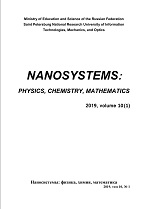|
CHEMISTRY AND MATERIAL SCIENCE
Synthesis and characterization of one pot electrochemical graphene for supercapacitor applications
R. Naresh Muthu
Department of Physics, J. P. College of Arts and Science, Tenkasi – 627852, Tamilnadu, India (Affiliated to Manonmaniam Sundaranar University, Tirunelveli, Tamil Nadu, India)
Abstract:
Graphene can be used to store energy as well as a supercapacitor material because of its unique physical and chemical properties, including high specific surface area, high chemical stability, high mechanical strength, and oxidation resistance. In this report, a facile, green, and cost-effective approach has been adopted to synthesize graphene sheets through an electrochemical exfoliation technique for supercapacitor applications. Graphene sheets were synthesized using aqueous electrolyte (Ag/AgCl, 0.1 M H$_2$SO$_4$) with four different exfoliation potentials such as 3, 5, 7 and 9 V. The prepared graphene sheets were subjected to characterization techniques such as Raman spectroscopy, X-ray photoelectron spectroscopy (XPS), X-ray diffraction (XRD), and atomic force microscopy (AFM). The Raman results revealed that the defect density and thickness of the graphene layers increased with increased in the exfoliation potential and then eventually decreased. Among all potentials, the maximum crystalline size of graphene was observed for the potential of 5 V, an intermediate crystalline size of 9 V, and minimum for 7 V, showing that the exfoliated graphene layer was sensitive to the exfoliation potential. XPS study shows the structural oxidation (relative percentage of carbon and oxygen) of the exfoliated graphene at different potentials. The results indicate that electrochemically exfoliated graphene (5 V) has been successfully produced. The behaviour of 5 V graphene has been examined using a charge-discharge (CD) curve and cyclic voltammetry (CV) for supercapacitor applications. The maximum value of specific capacitance obtained is 198 F$\cdot$g$\cdot$1 at a current density of 0.14 A$\cdot$g$^{-1}$ in 6 M KOH. The highest value obtained for energy density and power density is 17 W$\cdot$h$\cdot$kg$^{-1}$ and 1176 W$\cdot$kg$^{-1}$.
Keywords:
graphene, electrochemical exfoliation, supercapacitor, EDLC.
Received: 08.02.2023
Revised: 02.04.2023
Accepted: 04.04.2023
Citation:
R. Naresh Muthu, “Synthesis and characterization of one pot electrochemical graphene for supercapacitor applications”, Nanosystems: Physics, Chemistry, Mathematics, 14:3 (2023), 380–389
Linking options:
https://www.mathnet.ru/eng/nano1203 https://www.mathnet.ru/eng/nano/v14/i3/p380
|

| Statistics & downloads: |
| Abstract page: | 69 | | Full-text PDF : | 29 |
|




 Contact us:
Contact us: Terms of Use
Terms of Use
 Registration to the website
Registration to the website Logotypes
Logotypes







 Citation in format
Citation in format 